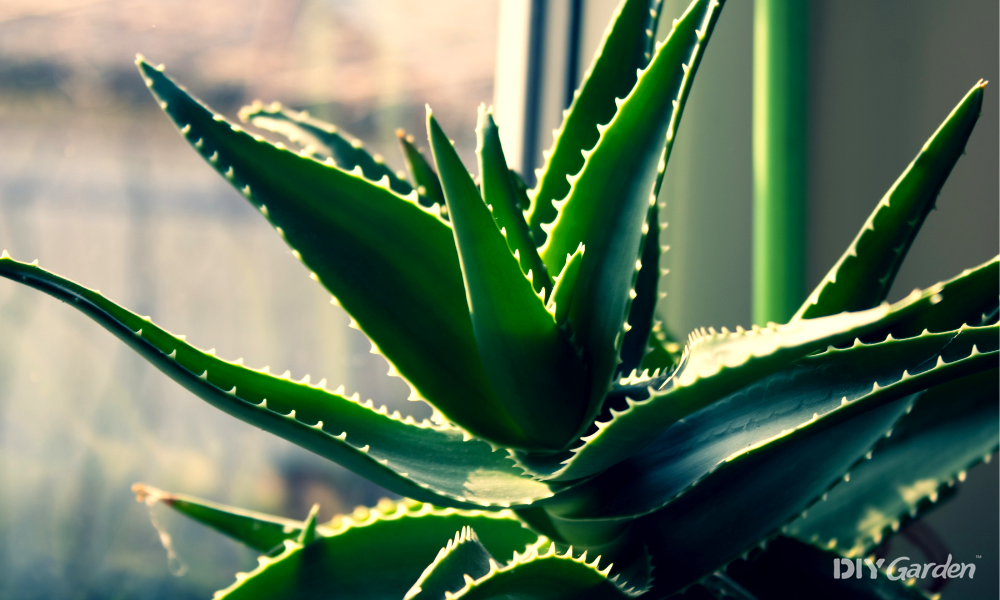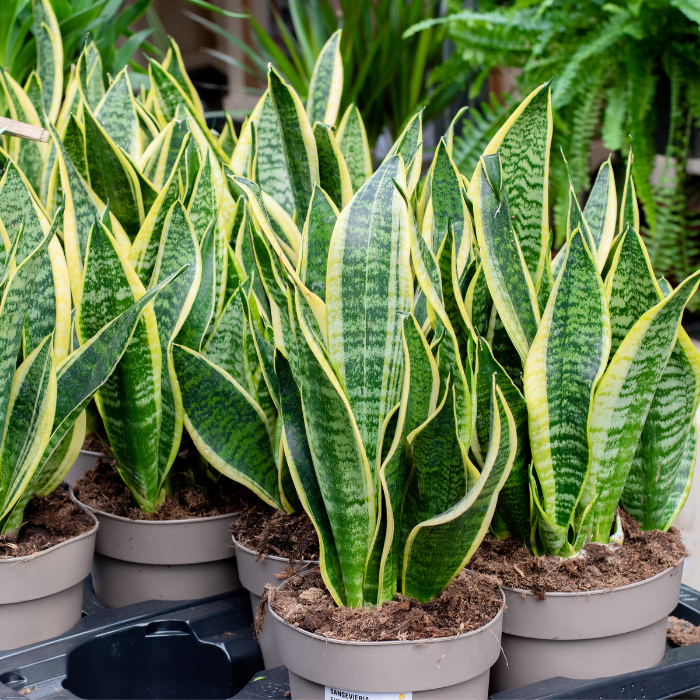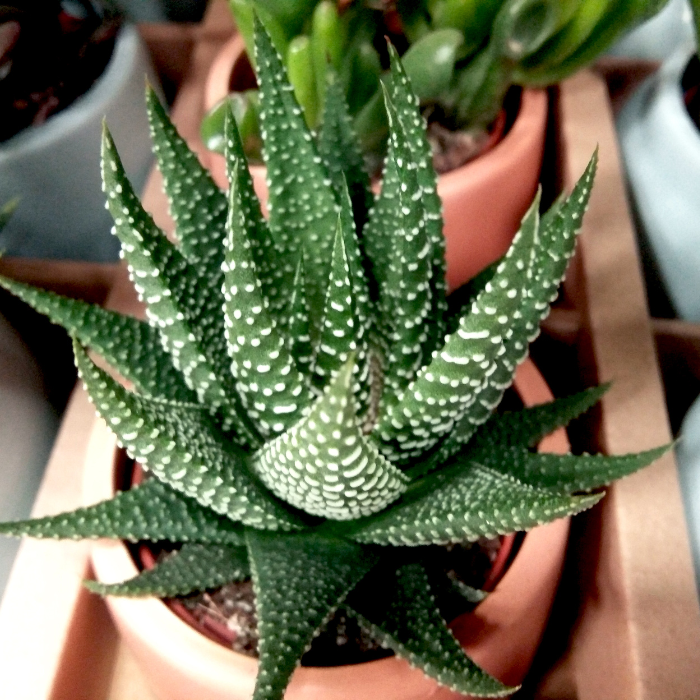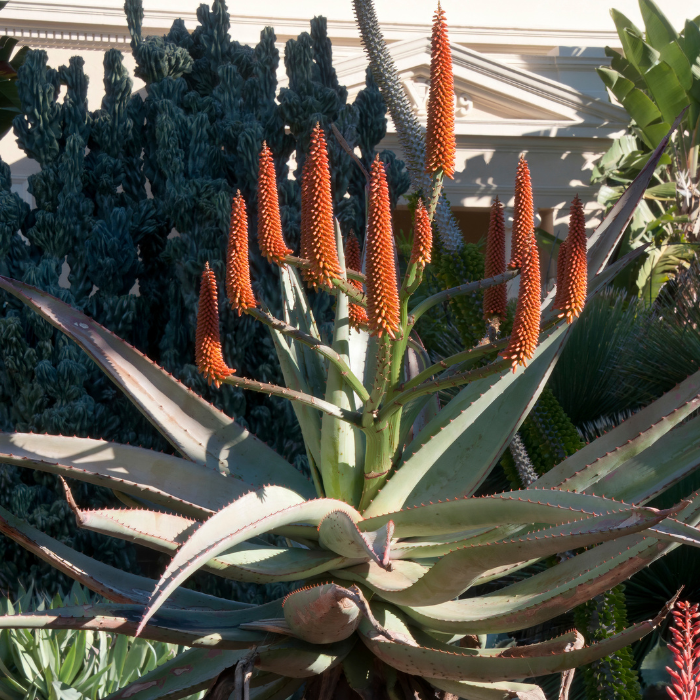
Aloe vera is a world-renowned plant that most people are familiar with. Originally from the Arabian peninsula, this succulent plant thrives in semi-arid and arid regions, making it the perfect low-maintenance plant for UK gardens.
The aloe vera plant’s thick, fleshy leaves are filled with what we know as aloe vera gel, a thick, clear substance that contains helpful enzymes, minerals, vitamins, amino acids, and so much more.
Due to these components, aloe vera has many healing properties, which we often use for medicinal purposes.
There are over 500 species within the aloe genus, with aloe vera being the most popular and well-known.
But what about the rest? And how about other plants that look like aloe vera but aren’t?
In this article, we’ll explore 17 aloe plant look-alikes – plants with a similar appearance to the beloved aloe vera.
Without further ado, let’s get started!
1. Yucca Plants
While many of the plants on this list are different types of aloe plants, we thought we’d kick things off with the yucca plant, an agave belonging to the asparagus family!
Yucca plants are evergreen perennials that can grow as a tree or shrub.
They possess green leaves with a sharp point at the end and large panicles of creamy white blooms in mid-summer to early autumn.
2. Snake Plant
You may have heard of the snake plant, as it’s a popular choice of houseplant in UK homes.
Its compact yet tall shape adds interesting height to a room, and its striking leaves with sharp edges and contrasting colour pattern catch the eye immediately.
And if that weren’t enough, it’s easy to care for, too!
It doesn’t require much light and barely needs watering. Allowing the soil to dry out between waterings is important. Otherwise, you risk root rot.
READ NEXT: 21 Best Plants for Rooms Without Windows
3. Haworthia Plants
Haworthia plants have many names – from zebra cactus to star window to cushion aloe – this succulent looks like a miniature aloe plant, with its spiky rosette of leaves adorned with white marks from the base right to its sharp edges.
Haworthia plants grow best indoors in the UK climate and will grow well in indirect (not full!) sunlight.
So, in real terms, that’s an east-facing window or a room that gets a good amount of sunlight but not on a sunny windowsill!
4. Zebra Plant
Continuing with the zebra theme, we present the zebra plant itself!
The zebra plant was given its name for obvious reasons – just look at it! The pattern of this plant’s leaves has a shocking resemblance to a zebra.
The zebra plant is another popular houseplant most loved for its leaves.
If you want this plant to flower, you may have to bear with it – it can be temperamental, and even when it does flower, its blooms may only last for 6 weeks.
5. Lace Aloe
Lace aloe, scientifically known as Aloe aristata, sports dark green leaves with white spots all across them.
This plant prefers warmer temperatures, so it doesn’t do so well against the UK climate.
However, it’s the ideal choice for a tropical houseplant! When lace aloe plants receive proper care, tall flower stalks with tens of orange flowers appear.
Needless to say, this plant puts on a spectacular show!
6. Agave Plants
We have already spoken about one Agave plant, the Yucca. But many more agave plants look like aloe vera, often due to the striking similarities in their leaves!
You have Agave parryi, which has blue-green leaves that share a similar shape to aloe vera.
There’s also Agave americana, an Agave species originally from Mexico and the US, which boasts longer leaves than aloe vera but a similar overall appearance.
So, what will it be?
7. Gasteria Succulents
Gasteria succulents have a weird but wonderful look, and that’s why people love them!
They’re also slightly rarer than your average houseplant, making them a great option for anyone looking for a more unusual look!
This succulent, like most, favours low light conditions, making it perfect for your home’s shady spots, like a windowless room or a darker corner of a well-lit room.
When buying a gasteria succulent, it’s best to choose wisely!
While some varieties can look nearly identical to aloe vera, such as the gasteria carinata, others, like the gasteria glomerata, are far from it!
8. Multiceps Bergeranthus
Multiceps Bergeranthus is a small plant with heaps of personality.
The term “multiceps” translates to “many-headed,” which aptly describes this plant’s numerous leaves that poke out here, there, and everywhere.
And then, as if out of nowhere, short, thin stems protrude from this plant’s leaves when summer arrives, and yellow flowers with a pink underside appear.
But don’t expect to see these blooms at night, as they close up and disappear, only to reappear again in the morning!
9. Dryland Bromeliads
Dryland bromeliads like dyckias and hechtias are succulent plants that are often mistaken for yucca and aloe vera.
Although extremely similar to each other, dyckias and hechtias are very different from other bromeliads as they are terrestrial, meaning they grow in the ground.
Typically, bromeliads are epiphytic, meaning they grow on trees.
Dryland bromeliads make great potted plants, but they also look excellent featured in xeriscaping.
The choice is yours!
10. Aloe Ferox
Also known as bitter aloe or cape aloe, this aloe species is believed to contain many of the medicinal properties of aloe vera plants.
It has been used in South African traditional medicine for centuries, with believed health benefits for eczema, arthritis, stress, and hypertension.
Aloe ferox stands tall at a maximum height of 10 feet and is best distinguished by the red-brown spines that adorn its spiky leaves.
11. Tree Aloe
Another species of aloe that resembles aloe vera is tree aloe or Aloidendron barberae.
However, it has one key difference – it’s a tree! This plant will become a captivating focal point in any garden due to its immense height of up to 20 – 30 feet.
You may be wondering, what makes this at all similar to aloe vera? Well, this tree has very similar-looking leaves to aloe vera, only they’re sitting atop tall, sculptural branches!
This plant is perfect for Mediterranean and xeriscape gardens as well as beds and borders.
But you can also grow the tree aloe in a container if you wish!
12. Maguey Plants

The maguey plant is a close relative of the agave, but it looks highly similar to the aloe plant due to its large, fleshy leaves.
So, what makes this plant different? Well, its leaves have a more powdery blue-green colour and are far larger, growing to an extraordinary 12 feet rather than the aloe vera’s 3.
The maguey plant’s height makes it the ideal choice for home security.
Simply line your fence or home boundary with this plant, and you’re unlikely to get unwanted intruders!
READ NEXT: 25 Spiky Plants, Hedges & Bushes (For Added Home Security)
13. Pineapple Plant
We spoke about terrestrial bromeliads before, but did you know the pineapple plant is one of these?
Native to Brazil, the pineapple plant boasts a dense rosette of sword-shaped leaves that can grow up to 3 feet long.
During the summer months, pineapple plants produce an abundance of red and purple flowers, which eventually combine to form the edible pineapple fruit we know and love.
14. Aloe Variegata
Aloe variegata – or Tiger aloe – is small but striking in its appearance, with thick, spiky-edged green leaves specked with white markings.
This plant is originally from South Africa and Namibia, so it prefers warm, consistent temperatures, making it the ideal houseplant.
Despite being so similar in appearance to aloe vera, it doesn’t make the official toxic plant list like aloe vera does.
However, some experts caution that it’s still toxic to pets, so beware!
READ NEXT: 45 Toxic Houseplants That Are Dangerous for Children & Pets
15. Red Hot Poker Aloe
The red hot poker aloe, also known as Aloe aculeata, is a famous aloe species in Southern Africa, as it was depicted on the old nickel 10-cent piece.
Red hot poker plants are stemless aloes, sporting a single rosette that grows straight from ground level.
Stemless aloes typically prefer to grow in moist conditions and full sun or partial shade, as this mimics their native setting.
16. Aloe Africana
Aloe Africana is another aloe species that comes from, you guessed it, Africa! South Africa, to be precise.
This aloe is highly adaptable to its surroundings, making it a great low-maintenance plant to have in your garden, whether it be a Mediterranean or xeriscape garden or something else entirely!
You’ll need a relatively big garden for this plant, as Aloe Africana can grow up to 6.5 feet tall and 2 feet wide!
17. Faucaria
We thought we’d finish with a slightly unusual aloe vera alternative – faucaria. This plant has odd-shaped leaves that resemble not only aloe vera but also teeth!
Its name derives from “fauces,” which translates to “animal mouth,” so this really is the plant’s defining feature.
The faucaria plant is only little, growing up to 7 cm in diameter, making it an excellent houseplant to sit on a sunny windowsill.
If you found this helpful and want more plant recommendations, you’ll love our article on 49 Low Maintenance Hardy Plants For Your Garden.





